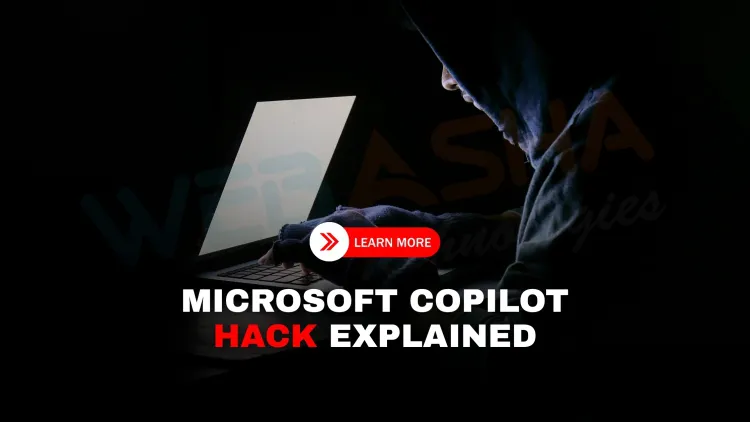How Did Microsoft Copilot Get Hacked? Root Access Vulnerability Explained with Full Technical Details (July 2025)
In July 2025, a serious vulnerability in Microsoft Copilot Enterprise was uncovered that allowed attackers to gain unauthorized root access to its backend container. The flaw originated from a misconfigured Python sandbox powered by Jupyter Notebook, where a malicious script disguised as pgrep exploited insecure environment variables and privilege mismanagement. This incident, disclosed by Eye Security, reveals the critical risks in AI-based sandboxes and underlines the importance of secure container configurations in enterprise AI tools. Microsoft patched the issue, but the case remains a benchmark in AI infrastructure vulnerabilities.

Table of Contents
- Introduction: What Happened to Microsoft Copilot?
- What Is Microsoft Copilot and Why Does It Matter?
- How Was Root Access Achieved in Microsoft Copilot?
- What Systems Were Exposed?
- Summary of the Vulnerability
- Why This Vulnerability Matters for AI Security
- Technical Breakdown: How the Attack Worked
- What Did Microsoft Do?
- Could This Exploit Have Gone Further?
- Lessons Learned for Developers and AI Engineers
- Conclusion
- Frequently Asked Questions (FAQs)
Introduction: What Happened to Microsoft Copilot?
In July 2025, security researchers from Eye Security disclosed a critical vulnerability in Microsoft Copilot Enterprise that allowed unauthorized root access to its backend container environment. The flaw stemmed from an April 2025 update introducing a Python-powered Jupyter sandbox, which unexpectedly became a launchpad for attackers to gain root-level privileges. Though the issue has been patched, the incident offers a sobering look into the vulnerabilities AI-integrated systems may introduce.
What Is Microsoft Copilot and Why Does It Matter?
Microsoft Copilot is an AI assistant embedded across the Microsoft 365 suite and other enterprise applications. It allows users to generate content, code, and analysis using natural language prompts. As part of this, it included a Jupyter-based Python execution sandbox that mimics development tools like ChatGPT’s code interpreter.
However, the increased flexibility and backend execution capabilities exposed Copilot to unforeseen threats — particularly when the environment wasn't hardened against traditional Linux container attacks.
How Was Root Access Achieved in Microsoft Copilot?
The vulnerability came from a design oversight in how the Copilot sandbox environment executed scripts.
Key Vulnerability Details:
-
A Jupyter Notebook sandbox was introduced, allowing
%commandexecution. -
The system ran as the ‘ubuntu’ user inside a Miniconda container, but some scripts ran as root.
-
The
entrypoint.shscript launched a service (keepAliveJupyterSvc.sh) as root. -
This script used a
pgrepcommand without a full path, relying on the$PATHvariable. -
Attackers uploaded a malicious script named
pgrepin a writable directory (/app/miniconda/bin) that appeared first in$PATH.
The result: Copilot executed attacker-controlled code as root.
What Systems Were Exposed?
The sandbox provided limited access, but once root access was achieved, researchers explored:
-
Filesystem using OverlayFS
-
Custom internal scripts located in
/app -
An internal web server on port 6000
-
Access to blob storage via Outlook blob links
-
A component called goclientapp for executing Jupyter code
No direct sensitive data was accessed, but the exploit showed how poorly protected entrypoint scripts and environment variables can lead to container privilege escalation.
Summary of the Vulnerability
| Component | Description |
|---|---|
| Affected Platform | Microsoft Copilot Enterprise (Python Sandbox, April 2025 update) |
| Vulnerable Script | entrypoint.sh (uses pgrep without full path) |
| Attack Vector | HTML-injected Python script disguised as pgrep in writable directory |
| Result | Root access inside backend container |
| Disclosure Date | April 18, 2025 |
| Patch Released | July 25, 2025 |
| Severity Level | Moderate (privilege escalation, no data leak) |
| Research Team | Eye Security |
Why This Vulnerability Matters for AI Security
AI tools like Microsoft Copilot rely on backend code execution to deliver dynamic features. While powerful, such environments are often sandboxed containers, which are susceptible to:
-
Improper privilege dropping
-
$PATH injection attacks
-
Lack of script sanitization
-
User-controllable file uploads
In this case, privilege mismanagement and missing binary path enforcement allowed a low-privilege user to run code as root. This could have led to ransomware, data exfiltration, or cross-container attacks if not contained.
Technical Breakdown: How the Attack Worked
Here’s how the exploitation happened:
-
The attacker uploaded a fake
pgrepscript into/app/miniconda/bin. -
This directory was ahead of
/usr/binin the $PATH, sopgrepinentrypoint.shcalled this malicious binary. -
This custom script:
-
Listened for commands in
/mnt/data/in -
Executed them using
popen -
Sent output to
/mnt/data/out
-
-
All of this happened with root privileges, due to the way
keepAliveJupyterSvc.shwas launched.
This abuse of insecure defaults shows how even readily available sandbox tools like Jupyter can be twisted with minimal effort if security isn’t baked in.
What Did Microsoft Do?
-
The issue was reported to Microsoft Security Response Center (MSRC) on April 18, 2025.
-
It was patched by July 25, 2025.
-
Microsoft acknowledged the research but did not offer a bounty.
-
The vulnerability was marked moderate and did not affect broader systems or customer data.
Could This Exploit Have Gone Further?
Yes — according to the researchers:
-
They hinted at access to the Responsible AI Operations panel
-
They found 21 internal services that could be targeted using Entra OAuth abuse
While nothing sensitive was taken, the attack surface was wide. It serves as a warning for any service that relies on code execution features — especially in cloud or AI-driven platforms.
Lessons Learned for Developers and AI Engineers
-
Always use full paths for binaries in scripts (
/usr/bin/pgrepvspgrep) -
Never allow writable directories to appear early in $PATH
-
Drop root privileges early and permanently when using containerized AI tools
-
Log sandbox behavior and restrict blob/file sharing
-
Limit what the sandbox can see — even if it’s just for code generation
Conclusion: Are AI Sandboxes the Next Big Threat?
This Microsoft Copilot issue is a reminder that AI sandboxes are double-edged swords. They enable innovation but also open dangerous backdoors when improperly configured.
The vulnerability didn’t expose user data — but the ability to gain root access with a clever upload proves that container security must evolve alongside AI.
As enterprises adopt tools like Copilot, security-by-design must be prioritized, or else AI's biggest strength — dynamic flexibility — will also be its greatest vulnerability.
FAQs:
What is the Microsoft Copilot root access vulnerability?
A vulnerability in Microsoft Copilot's backend sandbox allowed attackers to execute commands as root via a misconfigured script path.
Who discovered the Microsoft Copilot exploit?
The vulnerability was discovered by researchers at Eye Security.
When was the Copilot root vulnerability reported?
It was reported on April 18, 2025, to Microsoft’s Security Response Center (MSRC).
When did Microsoft patch the Copilot vulnerability?
Microsoft patched the issue on July 25, 2025.
How did attackers gain root access in Microsoft Copilot?
By uploading a fake pgrep script into a writable directory, which was executed due to its position in the system’s $PATH.
What feature introduced the vulnerability in Copilot?
An April 2025 update that introduced a Jupyter Notebook-powered Python sandbox.
Was the Copilot sandbox running as root?
Some scripts, including keepAliveJupyterSvc.sh, were unintentionally run as root.
What role did Jupyter Notebook play in the attack?
Jupyter allowed the use of %command syntax, which let users execute Linux commands inside the container.
Was this a remote code execution vulnerability?
Yes, it enabled remote execution of code via specially crafted payloads.
What is goclientapp in Microsoft Copilot?
It is a binary in /app that runs a web server for executing POST requests to Jupyter code endpoints.
Did the attack lead to data leakage?
No sensitive data was exposed according to the researchers.
What is OverlayFS in the Copilot container?
It is the filesystem used in the container that combined read-only and writable layers.
What is the /mnt/data path used for in Copilot?
It allowed file uploads and downloads via blob links, which attackers abused to exfiltrate script outputs.
Why was the pgrep command vulnerable?
It was called without its full path, allowing a fake version to be executed from earlier directories in $PATH.
Did Microsoft offer a bounty for this report?
No, but they acknowledged the researchers on their security research page.
What is the severity rating of this vulnerability?
Microsoft classified it as a moderate severity issue.
What is the significance of /app/miniconda/bin in the attack?
It was a writable directory in $PATH where the fake pgrep script was uploaded.
Was this vulnerability exploited in the wild?
There is no evidence it was exploited beyond the controlled research demo.
What does this incident say about AI sandbox risks?
It highlights how AI sandboxes can become attack vectors if not properly secured.
What is the role of entrypoint.sh in the attack?
It launched a critical script as root without properly specifying the binary path.
What is Entra OAuth abuse as hinted by researchers?
A potential method to access internal Microsoft services using improperly scoped OAuth tokens.
Was this attack possible due to missing sudo?
Yes, although the user was in the sudo group, the sudo binary was not present in the environment.
How does this compare to ChatGPT’s sandbox?
Microsoft Copilot used a newer kernel and Python 3.12, compared to ChatGPT’s 3.11.
Is Microsoft Copilot still safe to use?
Yes, the vulnerability has been patched, and no further issues have been publicly reported.
Did this attack require physical access?
No, it was executed entirely through the web interface of the sandboxed environment.
What are the security lessons from this incident?
Always specify binary paths, restrict writable directories, and drop root privileges early.
Can similar bugs exist in other AI tools?
Yes, any tool that runs user code in containers can be vulnerable if poorly configured.
What’s unique about AI-based attacks like this?
They blend traditional Linux attacks with modern AI interfaces, making them harder to detect.
Did the researchers exploit Microsoft services beyond Copilot?
They hinted at further findings involving Responsible AI Operations and 21 internal services.
Has Microsoft commented publicly on the issue?
As of now, Microsoft has not released a public statement beyond the acknowledgment.














![Top 10 Ethical Hackers in the World [2025]](https://www.webasha.com/blog/uploads/images/202408/image_100x75_66c2f983c207b.webp)








